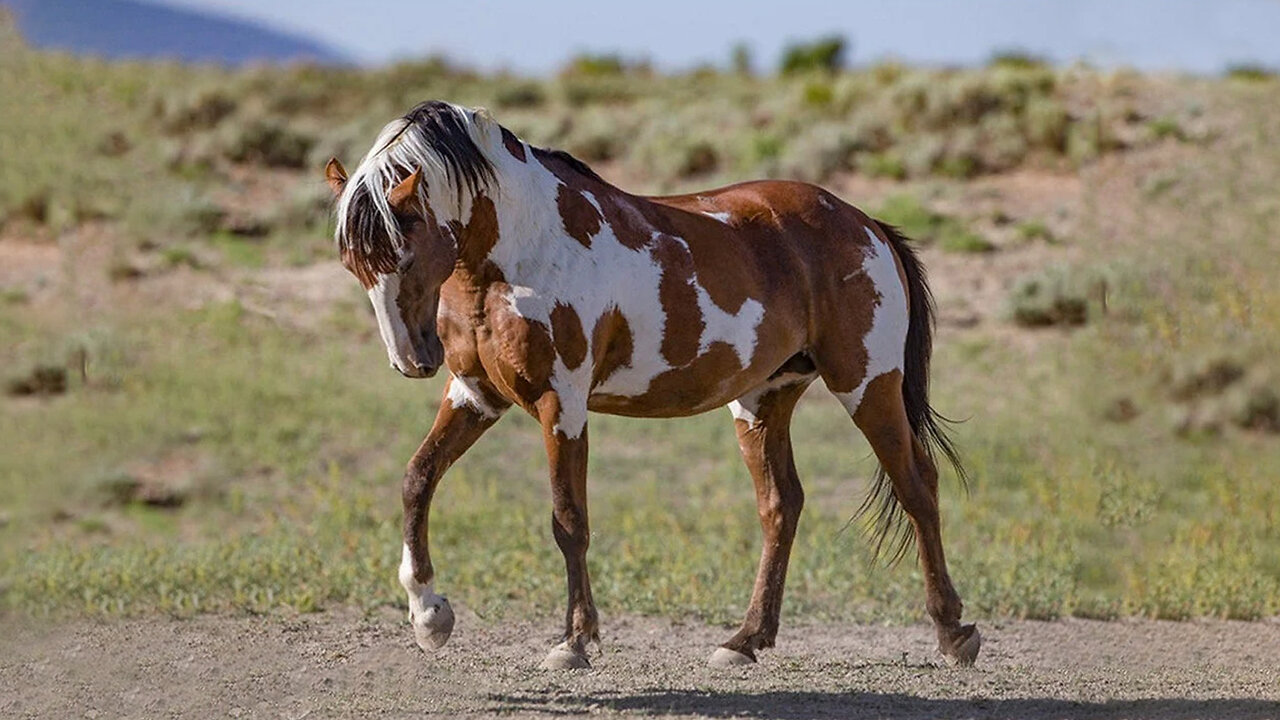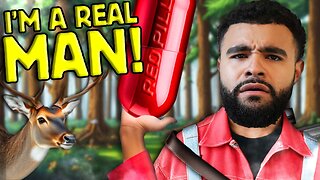Premium Only Content

Beautiful Wild Horses You have never seen Before
In the world of nature's most mesmerizing creations, wild horses stand as living masterpieces. They are the embodiment of untamed freedom, their presence an eloquent testament to the beauty that thrives beyond the confines of domestication. These magnificent creatures have held humanity spellbound for centuries, inspiring awe and reverence with their graceful forms and spirited existence.
But where do they come from? What different breeds exist? We're going to answer all these questions in this video as we look at beautiful wild horses from around the world. Without any further ado let's get started.
Number 11 - Sorraia
In the early 20th century, the Sorraia horse, a fascinating Portuguese wild breed, came out of obscurity. Scientists believe it's one of the oldest horse breeds still around, and they're studying its origins. Sorraias are easy to spot with their Iberian looks and grullo coat color, usually dun or grullo. Their tails and manes go from light to dark, and they often have dark muzzles and occasional white markings. Even newborn foals can appear striped due to their hair arrangement. With only a few hundred Sorraias left, conservation efforts are in full swing to protect this special breed. In the United States, dedicated breeders are working on preserving Sorraia bloodlines and creating the American Sorraia Mustang breed.
Number 10 - Brumby
In the vast and rugged landscapes of Australia, the Australian Heritage Brumby embodies the essence of freedom. These horses roam freely through the harsh outback, where they thrive in extreme conditions. Brumbies come in diverse colors, heights, and types, reflecting their mixed lineage from various horse breeds. Their remarkable hardiness and strong survival instincts make them exceptional animals.
When captured, Brumbies can adapt to various roles, becoming versatile riding or workhorses. The Heritage Brumby is a direct descendant of the first horses that arrived on Australian shores with convicts and settlers in 1788. Initially, only seven horses survived the arduous voyage. These mares and stallions demonstrated exceptional hardiness, evolving through natural selection and survival of the fittest during the 1800s to endure the intense heat, cold, and snowy conditions found in various parts of this diverse country.
Number 9 - Camargue
If you ever find yourself in Southern France, don't miss the chance to explore the enchanting Camargue Natural Park. Nestled along the Mediterranean Sea, this park is a haven of wetlands and marshes. However, what truly captivates horse enthusiasts and photographers alike are the magnificent Camargue horse herds. People from around the globe flock here to witness and capture the beauty of these intelligent and graceful creatures.
These free-roaming horses belong to one of the world's most ancient breeds, with roots dating back to the Camargue region long before Roman times. Genetic studies even reveal that Camargue bloodlines have left their mark on many modern Spanish horse breeds, indirectly influencing American horse breeds as well. So, when in Southern France, make sure to immerse yourself in the allure of Camargue Natural Park and its captivating equine inhabitants.
Number 8 - Konik
Meet the Konik, a remarkable Polish wild horse breed that thrives in semi-feral conditions within nature reserves across Europe. Long believed to be the descendants of the extinct Tarpan, genetic studies have debunked this theory.
The Konik played a significant role in the creation of the Heck Horse, an effort to recreate the ancient Tarpan. Additionally, Koniks were crossed with Thoroughbreds to produce a more athletic-looking riding horse.
Today, a population of approximately a couple thousand Konik horses roams the world, with minimal human interference, primarily in nature reserves. These resilient horses can be found not only in their homeland, Poland, but also in countries like the Netherlands, Spain, Belarus, Latvia, and the United Kingdom. Explore the world of the Konik, a living link to Europe's wild horse heritage.
Number 7 - Mustang
The Mustang, a symbol of freedom, roams freely across the vast western states of the USA. Although often seen as "wild," it descends from domesticated horses brought to the country by Spanish conquistadors.
Mustangs are celebrated as one of the most renowned Native American horse breeds globally, embodying the pioneering spirit of the American West. They come in diverse body types and coat colors, reflecting their varied genetic compositions. DNA testing has unveiled Spanish, draft horse, pony, gaited horse, and even Thoroughbred heritage among different Mustang herds.
These horses are legendary for their stamina and unwavering loyalty, rivaling Arabian horses in endurance competitions while excelling in various disciplines. The Mustang's captivating story and enduring spirit continue to captivate horse enthusiasts and admirers of the American West alike. This iconic breed stands as a testament to the untamed beauty of the western United States.
Number 6 - Pottok
The Pottok is a horse breed originating from the Basque Country. This slender yet robust animal is considered an ancient breed, well-suited for the harsh mountain regions it traditionally calls home. Sadly, it faces endangerment due to habitat loss, mechanization, and crossbreeding, but dedicated efforts are underway to secure its future.
Measuring between 1.15 to 1.47 meters in height and weighing 300 to 350 kilograms, the Pottok boasts a distinctive appearance. It features a large, square head, small ears, a short neck, and a long back, supported by short yet slim legs and small, sturdy hooves.
The Pottok's resilience and adaptability to mountainous terrains make it a vital part of the Basque heritage. Conservation initiatives aim to protect and preserve this unique breed, ensuring that the Pottok continues to thrive in its traditional homeland.
Number 5 - Garrano
Found in wild and semi-wild populations on the Iberian Peninsula,The Garrano boasts a history so ancient that Iberian palaeolithic cave paintings depict horses bearing a remarkable resemblance to them. Today, these rugged horses roam various mountainous regions of northern Portugal. The Garrano is a compact, lightweight horse, typically weighing around 290 kg and standing no taller than 13.1 hands high. Their coats are commonly solid and dark, with shades like bay, brown, and dark chestnut, featuring minimal white markings.
Considered an endangered breed, the Garrano has been under protection since the 1970s. Presently, there are approximately 2,400 Garranos in existence, although not all are purebred. Despite their modest height, these horses exhibit exceptional hardiness, strength, and endurance. They are eager workers, quick learners, and possess a friendly, relaxed temperament. Years of navigating challenging mountain terrain have made Garranos remarkably agile, preserving their place as a living testament to the Iberian Peninsula's equine heritage.
Number 4 - Welsh Pony
Wales has been home to its native ponies for centuries, even before the 17th century. While the exact origins of the Welsh pony remain somewhat unclear, the breed's development has been influenced by Thoroughbreds, Arabians, and Hackney horses over time. These ponies have thrived in their native habitat, the marshy, mountainous terrain of Snowdonia, which has molded them into incredibly hardy and resourceful survivors.
All Welsh ponies share distinctive characteristics, including small heads, expressive large eyes, sloping shoulders, and robust hindquarters. Their height can vary significantly, ranging from 11 to 16 hands.
The Welsh pony stands as a testament to Wales' rich equine heritage, adapting and thriving in the challenging conditions of its native terrain. With a blend of ancient roots and influences from various horse breeds, the Welsh pony continues to capture the hearts of horse enthusiasts around the world.
Number 3 - Namib Desert Horse
The Namib Desert Horse holds the distinction of being the only breed living in the wild across the entire African continent. As implied by its name, this remarkable breed calls the harsh environment of Namibia's Namib desert home, where their numbers are exceptionally low, typically ranging between just 90 and 150 individuals.
Namib Desert Horses, with their warmblood heritage, possess an athletic and muscular physique characterized by excellent conformation and sturdy bones. While bay is the most common coat color, chestnut and brown variations also exist, often displaying dorsal striping patterns.
These horses have not only adapted to survive in the challenging desert landscape but have also become subjects of scientific studies, shedding light on their impact on the local ecosystem. The Namib Desert Horse stands as a testament to nature's resilience and the ability of these remarkable animals to thrive in one of the world's most unforgiving environments.
Number 2- Chincoteague Pony
This wild pony breed roams the island of Assateague by the eastern shore of the United States. Their location also gives rise to their alternative name, the Assateague pony. Their origins are lost in the midst of time, but there are several theories. One is that they are descendants of horses from a wrecked Spanish galleon. Others believe that their ancestors were horses released in the 17th century by those looking to escape taxes on livestock. The ponies are small and sturdy, with an average height of between 12 and 13 hands. They have shaggy manes and tails, short legs and rounded bellies.
Number 1 - New Forest Pony
The New Forest, a beloved destination for millions of visitors worldwide, boasts a unique attraction: the 3,000 or more New Forest ponies that freely roam its heathland and woods. These native moorland ponies of the British Isles have been a part of the New Forest's landscape since ancient times, contributing not only to the forest's ecosystem but also to its cultural identity.
These ponies, while wild and untamed, can be captured and trained to reach elite competition levels. The New Forest and its ponies have formed a symbiotic relationship, shaping the character of this beautiful region in southern England. Without them, the landscape and experience of the New Forest would be vastly different.
While beauty is a subjective concept, some creatures undeniably captivate our hearts with their elegance. These rare wild horses may be admired from a distance, but for those interested in horses you can own and appreciate up close, there's a video showcasing such magnificent equines.
Even though beauty is subjective, we can all agree that some creatures are objectively more beautiful than others. These are some wild beauties but as you know they are rare wild horses and you only can admire them from a distance.
We hope you enjoyed the video, if you did please make sure to subscribe to our channel. Thank you for watching and we will see you in next video.
-
 2:44
2:44
BIG NEM
7 hours agoWhat's Really Behind the Fake Alpha Male Epidemic?
1.05K2 -
 57:20
57:20
State of the Second Podcast
7 days agoThe Inventor of Bump Stock Fights Back! (ft. Slide Fire)
1.31K2 -
 1:04:12
1:04:12
PMG
1 day ago $2.79 earned"I’ll be DRONED for Christmas!"
3.9K2 -
 23:38
23:38
RealitySurvival
1 day agoBest Anti-Drone Rounds For Self Defense
2.35K2 -
 57:43
57:43
barstoolsports
14 hours agoBest Shot Wins The Game | Surviving Barstool S4 Ep. 7
199K9 -
 1:52:24
1:52:24
Kim Iversen
10 hours agoLuigi Mangione Charged With TERRORISM | Liz Cheney Accused Of WITNESS TAMPERING, Faces 20 YEARS IN JAIL
105K131 -
 6:50:10
6:50:10
Akademiks
11 hours agoJay Z says he aint NEVER been friends w/ DIDDY! Bhad Bhabie lost her man? Travis Hunter Down Bad?
110K13 -
 2:27:04
2:27:04
AirCondaTv Gaming
9 hours ago $23.47 earnedWar Thunder - Tankering Around for That 10 Bomb
53.6K5 -
 4:19:05
4:19:05
SpartakusLIVE
12 hours agoThe MACHINE locks in for 12-hour POWER stream
37.1K1 -
 1:58:40
1:58:40
Robert Gouveia
11 hours agoJ6 Coverup: Prosecute LIZ CHENEY; NY Judge REJECTS Immunity; Trump Breaks Gag?
172K77